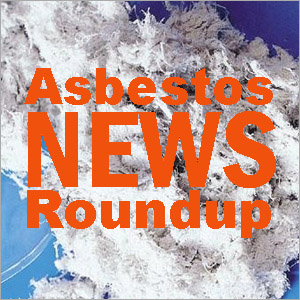Posts Tagged ‘ asbestos mine ’
Asbestos News Roundup: 6.14.12 – Local Asbestos Exposure in Town
June 14th, 2012. By LucyC
A roundup of recent asbestos-related news and information that you should be aware of. An ongoing list of reported asbestos hot spots in the US from the Asbestos News Roundup archive appears on our asbestos map.
Community Asbestos Exposure – Asbestos Around Town
You don’t have to work with asbestos containing products to suffer its effects. It is also possible to suffer asbestos exposure by living in a community or area located near an asbestos mine or a company that manufactures asbestos or products containing asbestos. Many older buildings may also contain asbestos insulation, including schools.
Perhaps the most famous victims of community contamination in North America are the residents of Libby, Montana, an asbestos-mining town. Vermiculite, which naturally contains asbestos, was mined there between 1923 and 1991. Workers and families of workers who lived in the town sued W.R. Grace, the last company to own the mine. At one point the company reportedly faced 110,000 lawsuits for sickening hundreds of people and contributing to the deaths of 225—allegedly with full knowledge.
Other examples of community exposure include the World Trade Center site after the terrorist attacks of September 11, 2001, and areas prone to damage from natural disasters like Hurricane Katrina. But it doesn’t take a disaster for asbestos exposure to occur locally in your community—our Asbestos Hot Spot Map shows locations across the US in which asbestos has been an issue and, in many instances, asbestos abatement has been needed.
Asbestos Settlements
Los Angeles, CA: The California 2nd District Court of Appeal in Los Angeles has ruled in favor of the wife of a mesothelioma victim who says she is entitled to damages against a manufacturer of asbestos products based on the loss of consortium with her husband.
Frederick Kenney of Fort Jones, CA, sued Tennessee-based auto parts manufacturer Hennessy Industries Inc. and other companies for negligence and products liability based on their use of asbestos products.
Mr. Kenney was diagnosed with mesothelioma in 2011 after being exposed to asbestos during his service in the U.S. Navy in the 1950s and 1960s, and when he later worked as a mechanic. His wife, Sherrell Vanhooser, filed a loss of consortium claim against the same defendants. Mesothelioma is a debilitating, deadly form of cancer caused by asbestos exposure.
In the asbestos lawsuit, attorneys argued that Ms. Vanhooser’s loss of consortium claim should be allowed. However, a Los Angeles County Superior Court judge granted Hennessy’s motion for summary judgment based on the argument that Mr. Kenney and his wife were not married until after Mr. Kenney last was exposed to asbestos.
Earlier this month, a three-judge panel from the 2nd District Court of Appeal ordered the trial court to vacate its order granting summary judgment, after finding that “injury to the spouse in the latent disease context occurs when the illness or its symptoms are discovered or diagnosed, not at the time of the tortious act causing the harm.” The case is Vanhooser v. Hennessey, No. BC-468065, in Los Angeles County Superior Court.
“This is an important ruling that will have far-reaching impact in asbestos litigation, as trial courts across California have been all over the map on this issue,” says Trey Jones, lead counsel for Ms. Vanhooser. “Husbands and wives are greatly impacted when a spouse develops an asbestos-related disease, so this ruling certainly moves them one step closer to justice.”
New York, NY: The lawsuits of two men who alleged a lifetime of working with asbestos led to their developing mesothelioma, a rare cancer that attacks the lining of the lungs have been successfully settled.
The asbestos settlement, consisting of an undisclosed payment said by the firm to be “substantial,” will benefit the families of the men. In a statement issued by attorneys for the plaintiffs, the settlement has come some time after both plaintiffs had already succumbed to lung cancer, with one man showing signs of pleural mesothelioma, a form of cancer closely associated with occupational inhalation of asbestos.
The two men, both long time sheet metal workers, were also Navy veterans. The Navy veterans’ asbestos lawsuits were challenging because although the men served in the Navy and were exposed to asbestos on certain ships or bases, they had no fellow service people who could verify that.
“Our clients, however, also worked at construction sites, and we were eventually able to locate several coworkers who testified to our clients’ presence near people working with asbestos-insulated valves, boilers and gaskets, among other products. They would cut these products and scrape off debris with wire brushes, which, according to the coworkers’ testimony, would send clouds of asbestos into the air. A chain of exposure like this makes for a very strong case,” said lawyers for Weitz & Luxenberg, who represented the plaintiffs. The men’s cases settled in the final days of five-week trial. (marketwatch.com)
Archive by Category
- Accidents (24)
- Airlines (9)
- Asbestos Mesothelioma (262)
- Automotive (25)
- Celebrity (14)
- Class Action (84)
- Complaints/Comments (15)
- Consumer Fraud (84)
- Contest (2)
- Court of Public Opinion (5)
- Crazy Sh*t Lawyers See (61)
- Criminal Law (4)
- Defective Products (111)
- DePuy ASR Hip Recall (2)
- Discrimination (22)
- Drugs/Medical (248)
- Elder Care Abuse (4)
- Emerging Issues (462)
- Employment (54)
- Environment (52)
- Financial (28)
- Food Illness (15)
- Human/Civil Rights (4)
- Insecurities (5)
- Insurance (16)
- Intellectual Property (16)
- Internet/E-commerce (19)
- lawsuits (161)
- Lawyers (20)
- Lawyers Giving Back (43)
- Lex Levity (10)
- Personal Injury (106)
- Pleading Ignorance (53)
- Real Estate (2)
- Recall (6)
- Scam (3)
- Securities (13)
- Settlement (81)
- Tort Reform (2)
- Totally Tortelicious (81)
- Veterans (11)
- Whistleblower (9)